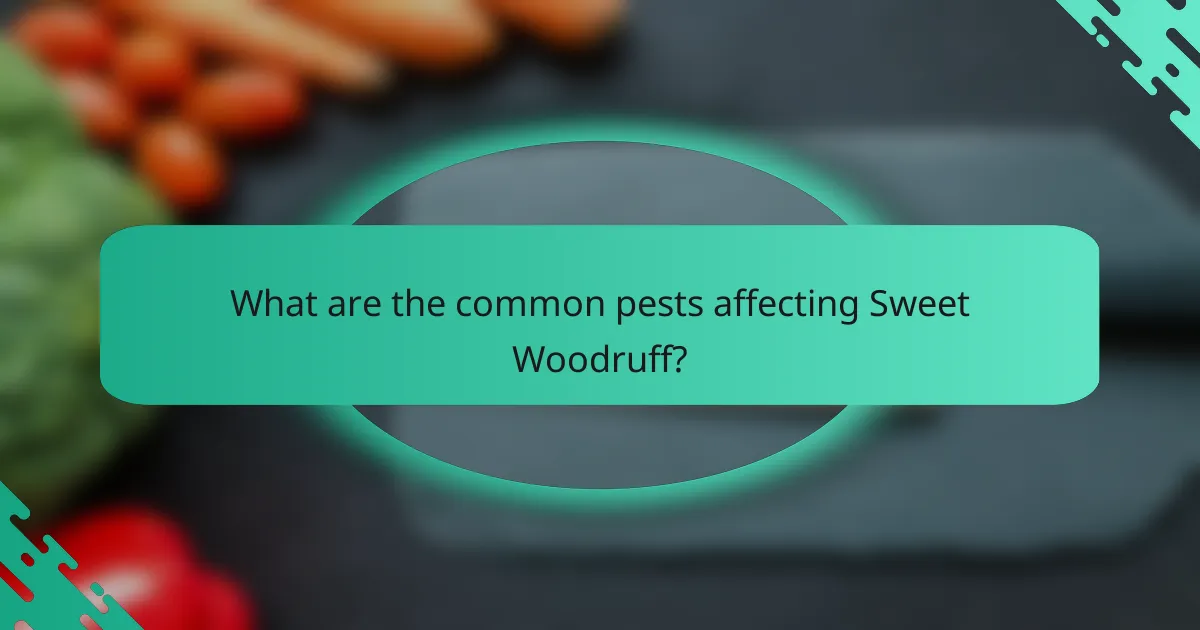When selecting Sweet Woodruff plants, it’s essential to look for indicators of quality such as vibrant foliage and robust root systems. In Los Angeles, several reputable garden centers provide healthy plants and expert advice, ensuring your gardening success. Be cautious of signs of poor health, like yellowing leaves or root rot, which can hinder growth.

How to choose quality Sweet Woodruff plants in Los Angeles
To select quality Sweet Woodruff plants in Los Angeles, focus on vibrant foliage, robust root systems, and healthy growth patterns. These indicators will help ensure you are purchasing healthy plants that will thrive in your garden.
Look for vibrant green foliage
Healthy Sweet Woodruff plants should exhibit vibrant green leaves, which indicate good health and vitality. Avoid plants with yellowing or browning leaves, as these may be signs of stress or disease.
When inspecting foliage, check for uniformity in color and texture. Plants with consistent green coloration are more likely to adapt well to your garden conditions.
Check for healthy root systems
A strong root system is crucial for the overall health of Sweet Woodruff. When possible, gently remove the plant from its pot to inspect the roots. Look for white or light tan roots that are firm and well-developed.
Avoid plants with dark, mushy, or overly compacted roots, as these can indicate root rot or poor growing conditions. Healthy roots should fill the pot without being tightly bound.
Assess growth habits and spacing
Sweet Woodruff typically spreads and forms a dense ground cover. When selecting plants, consider their growth habits and ensure they have adequate spacing for optimal growth. Look for plants that are bushy and well-branched rather than leggy or sparse.
In your garden, aim for spacing of about 12 to 18 inches between plants to allow for their natural spread while preventing overcrowding.
Inquire about organic growing practices
Choosing Sweet Woodruff plants grown using organic practices can lead to healthier plants and a more sustainable garden. Ask the garden center about their growing methods, including whether they use organic fertilizers and pest control.
Organic plants are often more resilient and can better adapt to local conditions, making them a worthwhile investment for your Los Angeles garden.

What are the best garden centers for Sweet Woodruff in California?
For those seeking Sweet Woodruff plants in California, several reputable garden centers stand out. These centers offer quality plants, knowledgeable staff, and a variety of gardening supplies to help you successfully cultivate this unique ground cover.
Green Thumb Nursery in San Diego
Green Thumb Nursery is a well-known destination for garden enthusiasts in San Diego. They stock a diverse range of plants, including Sweet Woodruff, and provide expert advice on plant care and garden design.
When visiting, look for healthy, vibrant plants with no signs of pests or disease. The staff can assist you in selecting the right variety for your garden’s conditions, ensuring optimal growth.
Armstrong Garden Centers in Los Angeles
Armstrong Garden Centers, with multiple locations in Los Angeles, is another excellent choice for purchasing Sweet Woodruff. They focus on high-quality plants and offer a wide selection of gardening tools and supplies.
Check for plants that are well-watered and have robust foliage. Armstrong’s knowledgeable team can guide you on the best practices for planting and maintaining Sweet Woodruff in your garden.
California Cactus Center in Pasadena
California Cactus Center specializes in a variety of plants, including unique ground covers like Sweet Woodruff. Located in Pasadena, this center is known for its friendly service and extensive plant selection.
When shopping here, ensure the plants are healthy and free from any damage. The staff can provide insights into the specific needs of Sweet Woodruff, helping you create a thriving garden space.

What are the signs of unhealthy Sweet Woodruff plants?
Unhealthy Sweet Woodruff plants exhibit several clear signs that indicate they may not be thriving. Key indicators include yellowing or wilting leaves, root rot, and pest infestations, all of which can significantly affect the plant’s health and growth.
Yellowing or wilting leaves
Yellowing or wilting leaves are often the first visible signs of stress in Sweet Woodruff plants. This can result from inadequate watering, either too much or too little, leading to nutrient deficiencies or dehydration.
To address this issue, check the soil moisture regularly. If the soil feels dry several inches down, it may need watering; conversely, if it’s soggy, reduce watering frequency. Healthy leaves should be vibrant green and firm.
Root rot or mushy roots
Root rot is a serious condition that affects Sweet Woodruff plants, often caused by overwatering or poor drainage. When roots become mushy and discolored, they can no longer absorb nutrients effectively, leading to further decline.
Inspect the roots by gently removing the plant from its pot. Healthy roots should be white and firm. If you find mushy roots, trim away the affected areas and repot the plant in fresh, well-draining soil to promote recovery.
Pest infestations on foliage
Pest infestations can severely impact the health of Sweet Woodruff plants. Common pests include aphids and spider mites, which feed on the foliage and can cause leaf discoloration and distortion.
Regularly inspect the leaves for signs of pests, such as sticky residue or webbing. If you notice an infestation, treat the plant with insecticidal soap or neem oil, ensuring to cover both the tops and undersides of the leaves for effective control.

How to care for Sweet Woodruff plants after purchase?
To care for Sweet Woodruff plants after purchase, ensure they are placed in suitable conditions that mimic their natural habitat. Focus on providing partial shade, maintaining moisture, and using well-draining soil to promote healthy growth.
Provide partial shade and moisture
Sweet Woodruff thrives in partial shade, which helps prevent leaf scorch and promotes lush foliage. Aim for a location that receives filtered sunlight or dappled shade for most of the day.
Moisture is crucial for Sweet Woodruff, as it prefers consistently damp soil. Water the plants regularly, especially during dry spells, but avoid waterlogging, which can lead to root rot.
Use well-draining soil
Well-draining soil is essential for Sweet Woodruff to prevent excess moisture retention. A mix of garden soil, compost, and sand or perlite can create the ideal conditions.
Consider testing the soil drainage by watering the area and observing how quickly the water absorbs. If it pools, amend the soil to improve drainage before planting.
Fertilize during the growing season
During the growing season, typically from spring to early summer, fertilize Sweet Woodruff to support its growth. A balanced, slow-release fertilizer can provide necessary nutrients without overwhelming the plant.
Apply fertilizer according to package instructions, usually every 4-6 weeks, but be cautious not to over-fertilize, as this can lead to excessive leaf growth at the expense of flowering.

What are the common pests affecting Sweet Woodruff?
Sweet Woodruff can be affected by a variety of pests that may hinder its growth and overall health. Recognizing these pests early is crucial for effective management and maintaining a thriving garden.
Aphids and spider mites
Aphids and spider mites are common pests that can infest Sweet Woodruff, leading to stunted growth and yellowing leaves. Aphids typically cluster on new growth and can be identified by their small, pear-shaped bodies, while spider mites create fine webs on the undersides of leaves.
To manage these pests, consider using insecticidal soap or neem oil, which are effective and less harmful to beneficial insects. Regularly inspecting your plants can help catch infestations early, allowing for prompt treatment.
Slugs and snails
Slugs and snails are notorious for feeding on Sweet Woodruff, especially in damp conditions. They leave behind irregular holes in the leaves and a slimy trail, making them easy to identify.
To deter these pests, create barriers using copper tape or diatomaceous earth around your plants. Additionally, handpicking them in the early morning or late evening can significantly reduce their numbers.
Whiteflies and mealybugs
Whiteflies and mealybugs can also pose a threat to Sweet Woodruff, sucking sap from the plant and weakening it over time. Whiteflies are small, white, and fly away when disturbed, while mealybugs appear as cottony masses on stems and leaves.
Controlling these pests involves introducing natural predators like ladybugs or using sticky traps to catch adult whiteflies. For mealybugs, a cotton swab dipped in alcohol can effectively remove them from the plant’s surface.

What are the benefits of growing Sweet Woodruff in your garden?
Growing Sweet Woodruff offers numerous benefits, including its fragrant foliage, attractive ground cover, and ability to thrive in shaded areas. This perennial plant is not only visually appealing but also serves practical purposes, such as attracting beneficial insects and suppressing weeds.
Quality indicators for Sweet Woodruff plants
When selecting Sweet Woodruff plants, look for healthy, vibrant green leaves and a robust root system. Avoid plants with yellowing leaves or signs of disease, as these indicate poor health and may not thrive in your garden.
Additionally, check for a strong, pleasant aroma when the leaves are crushed, as this is a sign of quality and freshness. Healthy plants should also have a bushy appearance, indicating good growth and vitality.
Choosing the right garden center for Sweet Woodruff
Selecting a reputable garden center is crucial for obtaining quality Sweet Woodruff plants. Look for centers that specialize in native or perennial plants, as they are more likely to carry healthy specimens suited for your local climate.
Ask staff about the source of their plants and whether they follow sustainable practices. A knowledgeable staff can provide insights on plant care and local growing conditions, ensuring you make an informed choice.
Tips for growing Sweet Woodruff successfully
To grow Sweet Woodruff successfully, ensure it is planted in well-drained soil with partial to full shade. This plant prefers moist conditions, so regular watering is essential, especially during dry spells.
Avoid over-fertilizing, as this can lead to excessive leaf growth at the expense of flowering. Instead, apply a balanced fertilizer sparingly in early spring to promote healthy growth without overwhelming the plant.


